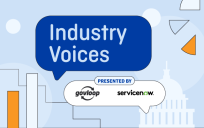As a public leader in the 21st century, it’s no longer enough to hide behind press releases and scripted speeches. Today’s society demands a different kind of leader — one who’s authentic, accessible and unafraid to engage.
Before you think you have to jump on the next social media trend, consider the impact of thought leadership in building trust and credibility with the public.

The Trust-Credibility Nexus in Public Leadership
While society is more connected than ever, public trust in government officials is hitting record lows. Traditional governance roles keep public leaders safely behind their desks instead of out with their constituency.
Social media has thrown open the doors to access, but it’s also made most leaders afraid of the public scrutiny that comes with the attention. The public is hungry for authenticity, but they are quick to spot and call out inauthentic content.
This trust deficit on both sides creates an opportunity for leaders who can learn to wield modern thought leadership effectively.
Thought Leadership Strategies for Government Leaders
Forget the idea that thought leadership is about dry policy briefs and jargon-heavy corporate comms. Modern thought leadership is about using available media to start conversations instead of delivering monologues. It’s as much about listening and engaging as it is about speaking, and it’s happening across every platform, from LinkedIn to X and even government websites.
So, how do you build trust when skepticism is at an all-time high?
Start by choosing authentic thought leadership. Share behind-the-scenes glimpses of your work, admit when you don’t have all the answers, and use personal anecdotes to illustrate your points.
But you shouldn’t stop at sharing your own voice. Instead, amplify diverse viewpoints within your organization, collaborate with unexpected partners and host digital town halls or AMAs (Ask Me Anything sessions).
By now, we know that ducking the hard questions is not an option. Address public concerns before they balloon into full-blown crises. Break down complex ideas and issues into digestible content, and always offer solutions, not just problems.
Let’s be honest — most constituents find policy stuff about as exciting as watching grass grow. Your job is to use storytelling to bring data to life. Create “what if” scenarios to illustrate policy impacts or develop interactive tools that let the public explore the data themselves.
Where to Share Your Thought Leadership
While traditional op-eds still have their place, your thought leadership strategy needs to be as diverse as your constituency. Consider launching a podcast series or hosting virtual chats with other thought leaders on LinkedIn via their LinkedIn Live feature.
The key is to meet your audience where they are so you can share your insights and engage in meaningful-to-them ways.
Authentic Public Leadership is Achievable
Thought leadership is not easy. You’ll face disagreements, struggle with information overload, risk getting trapped in echo chambers, and fail to keep up with 24-hour news cycles. But the payoff is worth it.
Thought leadership is the key to building a personal brand and catalyzing movements. When done authentically, it can inspire action and fundamentally change how the public interacts with the government. By participating in this type of governance, you are helping to shape what public leadership looks like in this new digital age.
Your audience is waiting and ready for a new kind of leader — one who’s real, relatable and open to change. Authentic thought leadership is your ticket to transforming public perception and the very nature of public service.
Jen Nieto is the founder of Civica Growth, a B2G content marketing consultancy helping GovTech companies, government contractors, nonprofit organizations, and industry leaders communicate effectively with public sector audiences. Jen’s unique insider perspective, honed over a decade in federal, state, and local government, allows her to create content for her clients that resonates with and motivates government decision-makers. She holds a Master’s degree in Political Management from The George Washington University and is deeply interested in digital modernization’s potential to make government more responsive, efficient, and collaborative. Off-duty, you’ll find Jen devouring the latest fiction novel or sipping lattes on her patio, possibly doing both at once.




Leave a Reply
You must be logged in to post a comment.